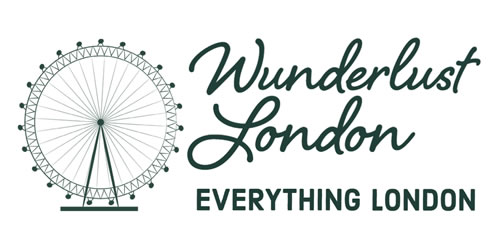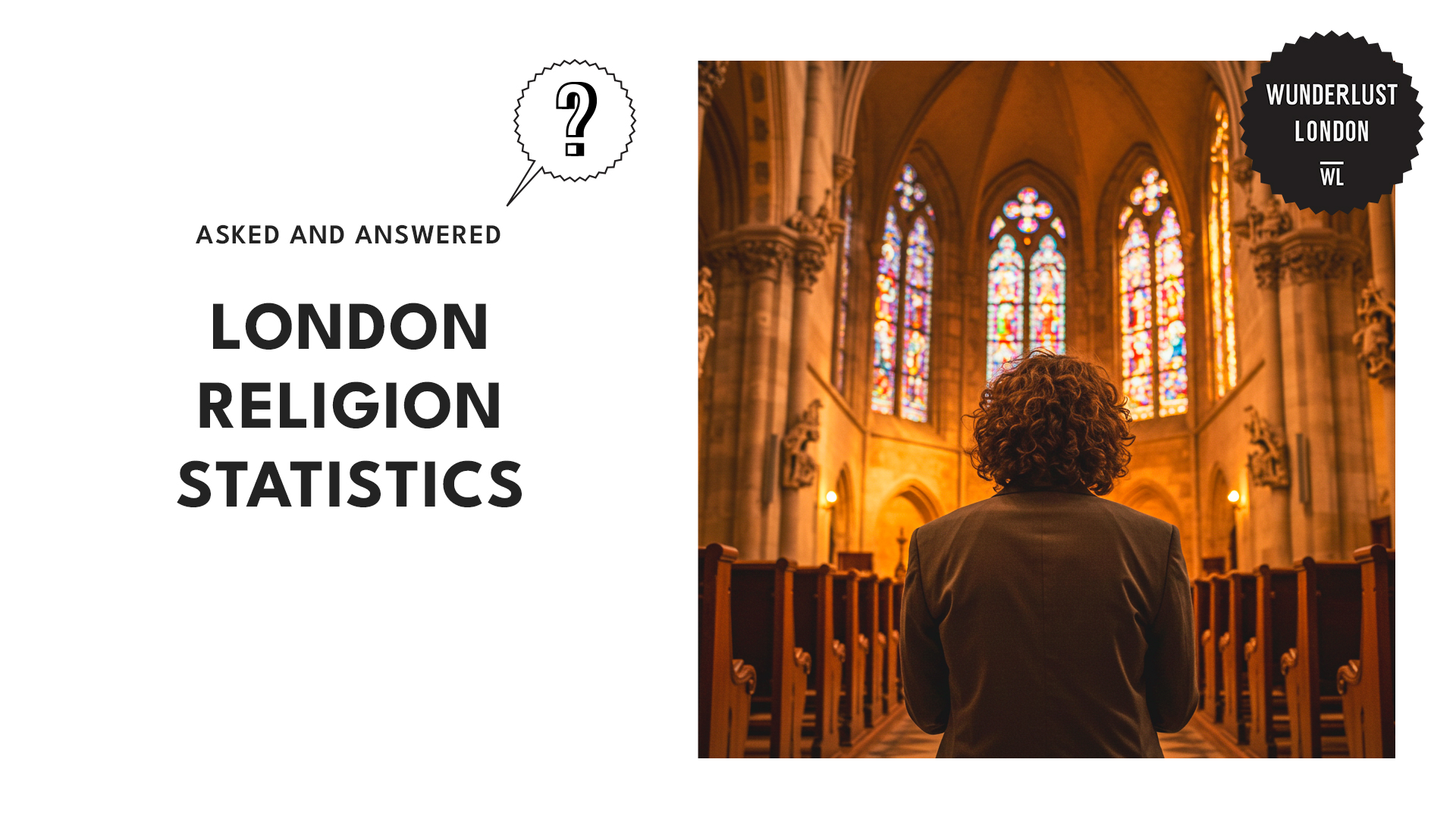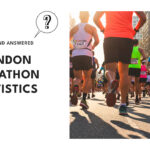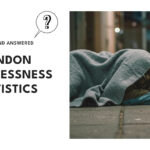Key insights
- The 2021 Census by the Office for National Statistics showed that fewer people in the UK identify as Christian, dropping from 59.3% in 2011 to 46.2% in 2021.
- According to the London Data Store, Newham, Tower Hamlets, and Redbridge have some of the highest numbers of religious people, mainly Muslims and Christians.
- London Data Store mentioned that Southwark, Croydon, and Bromley have a high number of people who identify as having no religion.
- Data from the Office for National Statistics shows that most religious groups in London are ageing, including Christians, Buddhists, Hindus, and Sikhs.
- The Office for National Statistics also found that more women (51%) than men (49%) identified with a religion.
- According to the Office for National Statistics, Muslims have the lowest employment rate and the highest level of economic inactivity.The National Churches Trust reported that UK churches contribute £12.4 billion each year.
London is one of the most diverse cities in the world. According to the London City Hall, its religious landscape has changed a lot since 2001.
Today, the city is home to more than 2,200 places of worship.
Religious affiliations in London
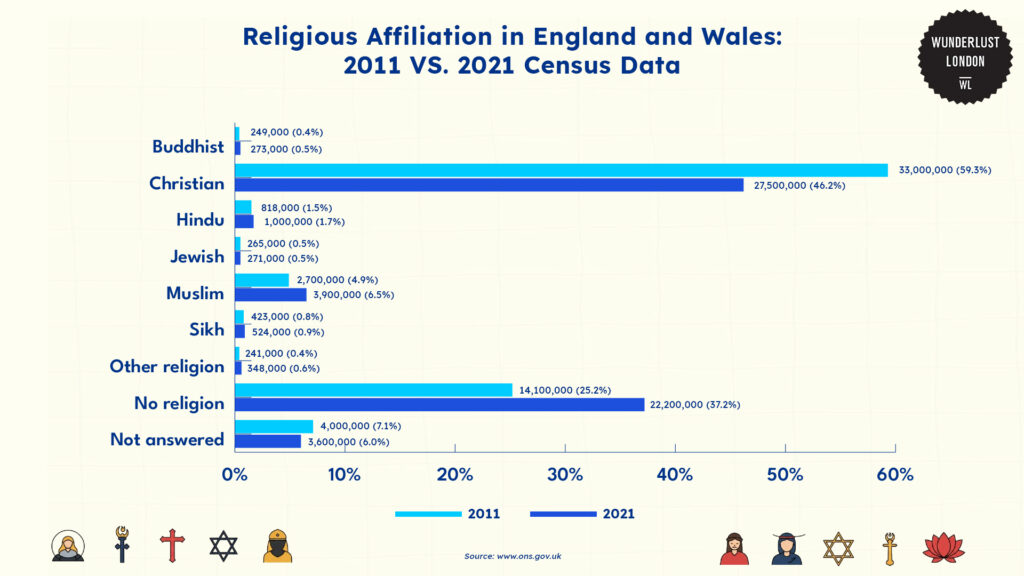
According to the 2021 Census of the Office for National Statistics, there are significant shifts in religious affiliation across England and Wales.
There has been a decline in the number of people identifying as Christians, dropping from 59.3% in 2011 to 46.2% in 2021. This may be due to increasing secularism, changing cultural norms, and generational differences in religious beliefs.
At the same time, there is a sharp rise in people reporting “No Religion.” It grew from 25.2% in 2011 to 37.2% in 2021.
This trend aligns with broader patterns seen in many Western countries, where younger generations are less likely to associate with organised religion. Greater social acceptance of non-religious identities might also influence the increase in this category.
Religion distribution in London boroughs
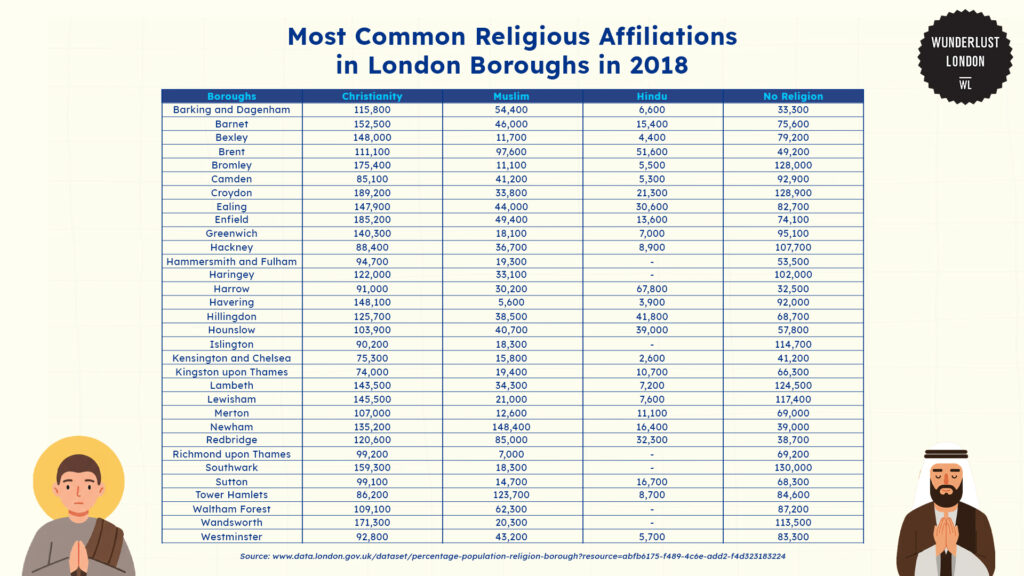
Based on the data from the London Data Store, different boroughs in London have different dominant faiths.
Newham, Tower Hamlets, and Redbridge have some of the highest numbers of religious people, especially Muslims and Christians. These areas have strong religious communities, with many mosques and churches playing a big role in daily life.
In Newham, there are more Muslims (148,000) than Christians (135,200). This makes it one of the Muslim-majority boroughs in London.
Meanwhile, Southwark, Croydon, and Bromley have a high number of people who identify as having no religion.
Southwark stands out with 130,000 people saying they have no religion. It’s the highest number of this group among all the other London boroughs.
Christianity distribution in London boroughs
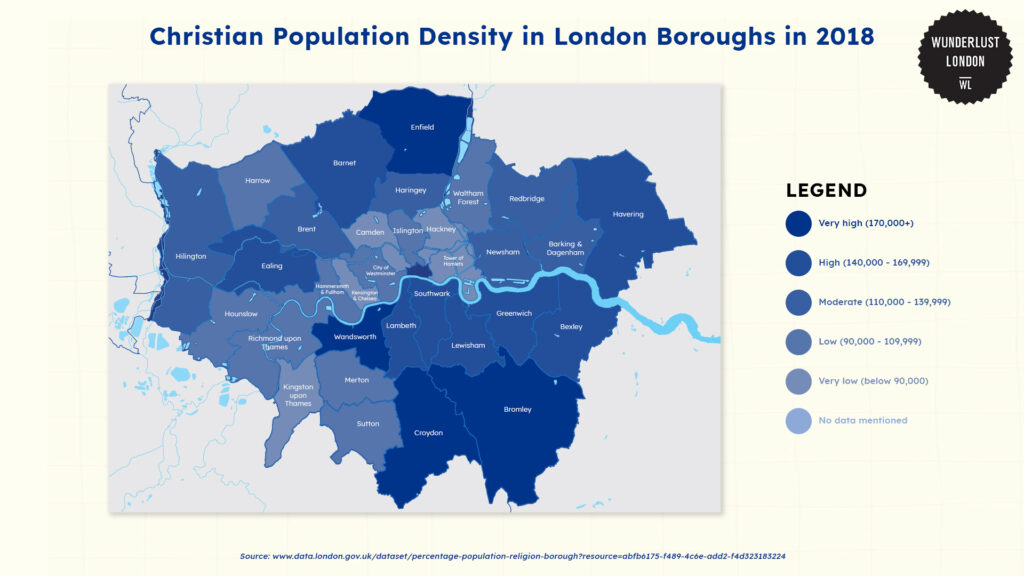
According to London Data Store, Christianity remains the most common religion in London, but its distribution varies across different boroughs.
Croydon, Enfield, and Bromley are some of the boroughs with the highest number of Christians. These areas have traditionally had strong Christian communities. Many churches also play an active role in local life.
On the other hand, Kingston upon Thames, Kensington and Chelsea, and Camden are among the areas with a lower number of Christians.
Islam distribution in London boroughs
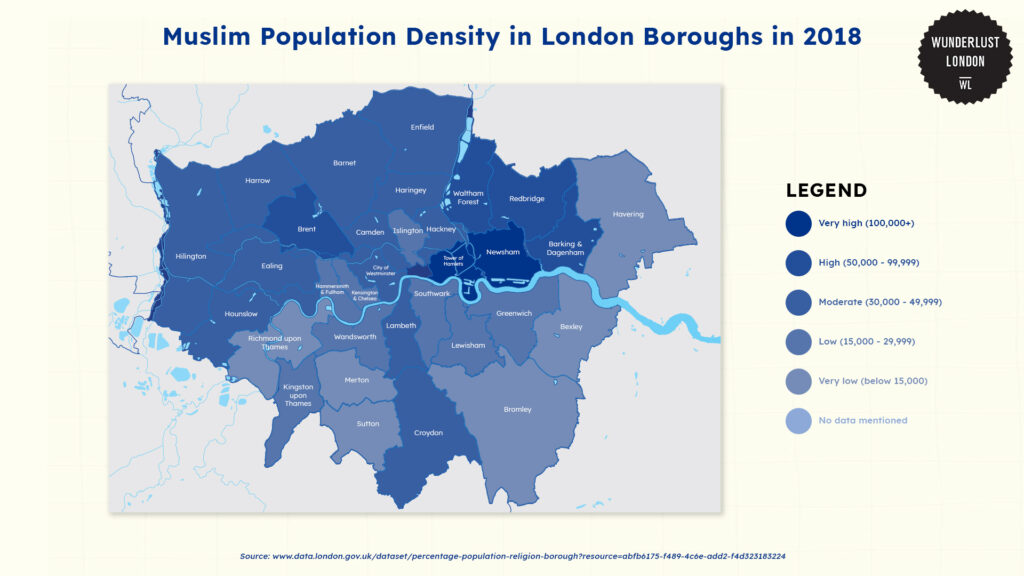
The Muslim population across London boroughs varies significantly, as reported by the London Data Store. Some areas have a much higher population than others.
Boroughs like Newham, Tower Hamlets, and Brent have the highest Muslim populations.
In contrast, boroughs like Havering, Richmond upon Thames, and Bromley have much smaller Muslim populations. Their numbers are below 15,000.
These areas are generally less diverse and have historically had fewer migrant communities, which explains the lower numbers.
Hindu distribution in London boroughs
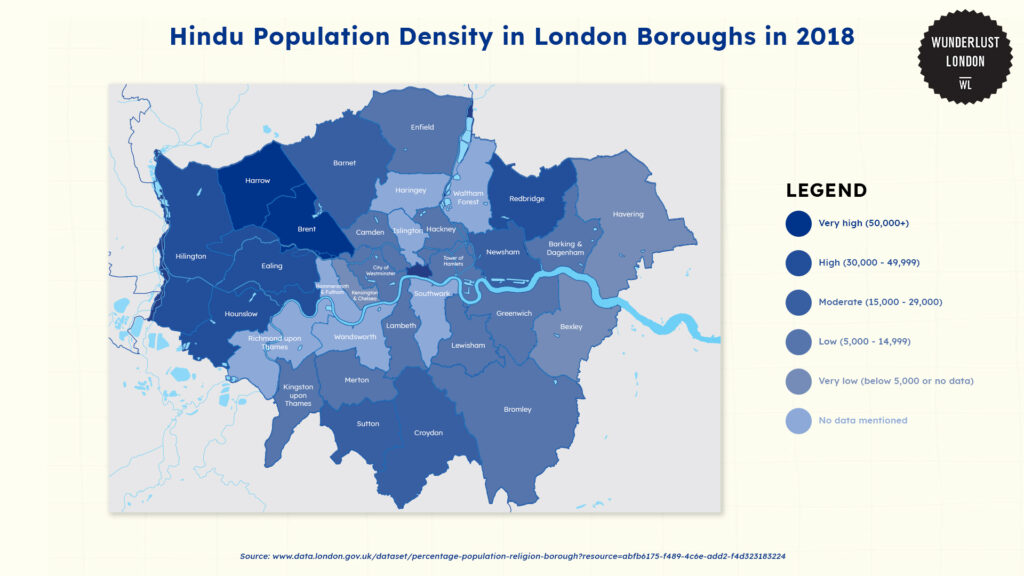
For the Hindu population in London, the London Data Store shows that Harrow stands out as the borough with the largest Hindu community. Other boroughs with large Hindu populations include Brent, Hillingdon, Hounslow, and Redbridge.
These areas have a well-established Indian and Nepalese presence. Religious sites like the famous Neasden Temple (BAPS Shri Swaminarayan Mandir) in Brent are major landmarks for Hindus in London.
Conversely, boroughs like Kensington and Chelsea, Bexley, and Camden have very small Hindu populations.
Some areas, such as Hammersmith and Fulham and Haringey, have no recorded data. This is likely because of a smaller South Asian presence, leading to minimal representation of Hindu residents.
No Religion in London boroughs
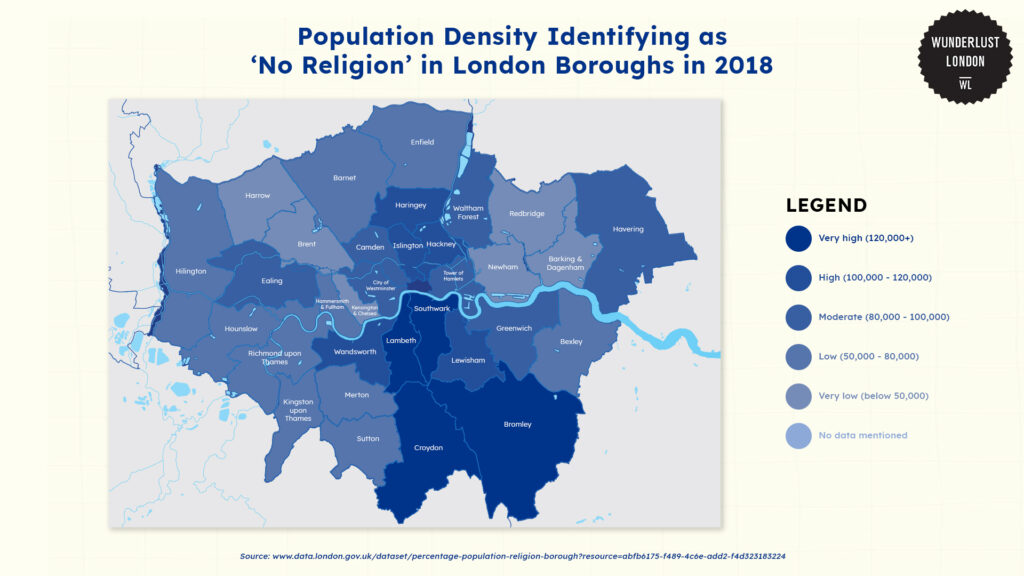
According to the London Data Store, boroughs like Southwark, Croydon, Bromley, and Lambeth have some of the highest numbers of people identifying as having no religion. Each borough has over 120,000 people.
Besides that these areas have a strong secular presence, it could also be possibly influenced by younger populations and diverse cultural backgrounds.
Meanwhile, boroughs like Harrow, Barking and Dagenham, Redbridge, and Newham have fewer people who identify as non-religious. These areas may have strong religious communities or cultural influences that encourage religious affiliation.
Waltham Forest’s religion distribution
Besides the data from London Data Store, additional in-depth information on the distribution of religions in Waltham Forest was found through the London Borough of Waltham Forest.
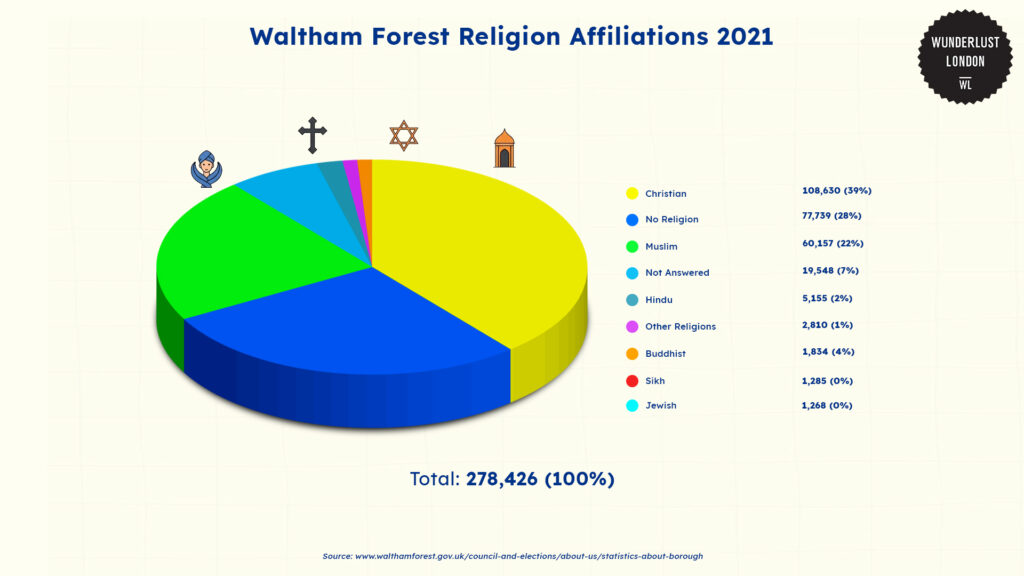
According to the London Borough of Waltham Forest, Christianity is the most common religion in its region, with 39% of people identifying as Christian.
There’s also a rising number of people with no religious affiliation (28%). This could mean that secularism is growing in the area.
Islam is also a major presence, with 22% of the population identifying as Muslim. This makes them the second-largest religion in Waltham Forest.
Smaller religious communities such as Hindus, Buddhists, Sikhs, and Jews are also present but make up a minor portion of the population.
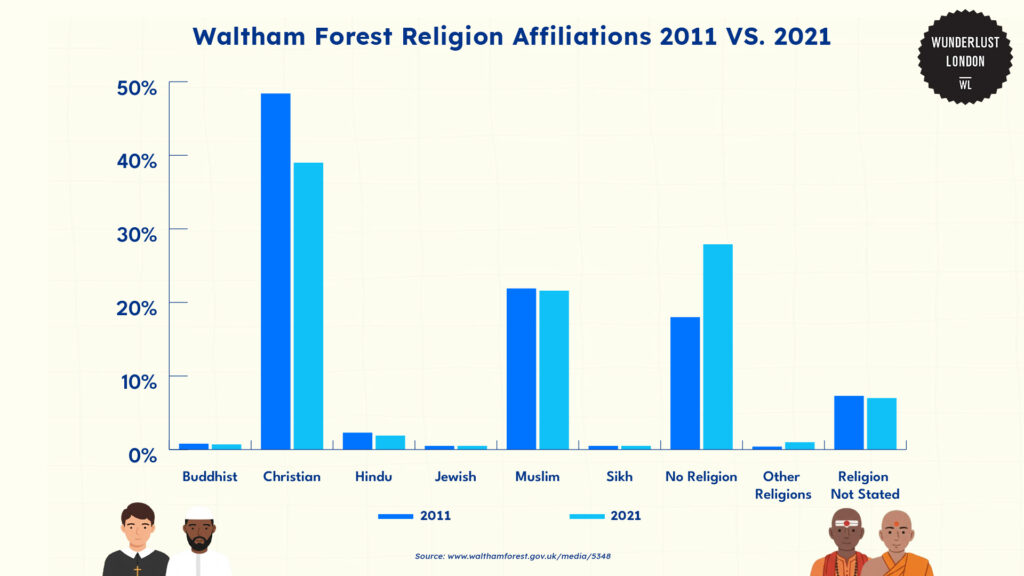
The London Borough of Waltham Forest also shared comparisons of religious affiliations in its borough between 2011 and 2021. It showed how religious identity has changed over a decade.
One of the biggest shifts is the decline in Christianity, which dropped from 48.4% in 2011 to 39% in 2021. This trend can be seen in many parts of the UK.
Islam remains a strong presence in Waltham Forest, with a slight decrease from 21.9% to 21.6%. The Muslim population has remained relatively stable over the years.
Other religions, such as Hinduism and Buddhism, have also seen small declines. On the other hand, the percentage of Jewish and Sikh individuals has stayed the same.
Comparison of religious affiliations in London with national trends
To give you a clear perspective of how religious affiliations are scattered in London, Waltham Forest and England, the following illustration compares the percentages of Christians, Muslims and those with no religion.
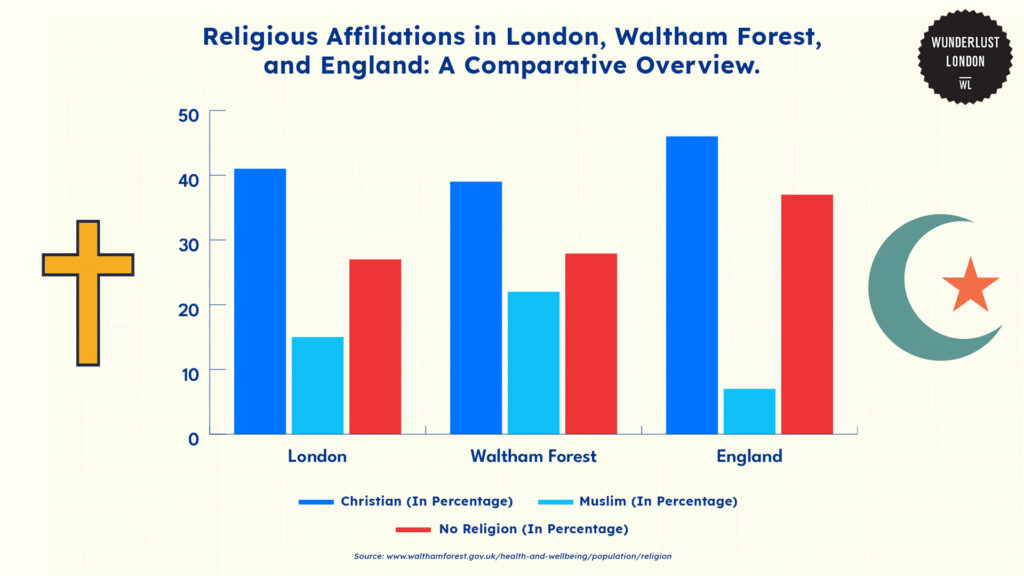
Based on the data by the London Borough of Waltham Forest, England as a whole has the highest percentage of Christians at 46% compared to London and Waltham Forest.
It suggests that Christianity remains more dominant on a national level, while urban areas, especially in London, tend to have a more diverse religious landscape.
When it comes to the Muslim population, it’s interesting that Waltham Forest has the highest percentage compared to London and the whole of England.
Possibly, the presence of Islamic schools, cultural centers, and strong community organisations make the borough an appealing place for Muslim families to stay in.
In England, 37% of people identify as having no religion, which is significantly higher than both London (27%) and Waltham Forest (27.9%).
Religious demographics in London
Demographic analysis of religions in London by age
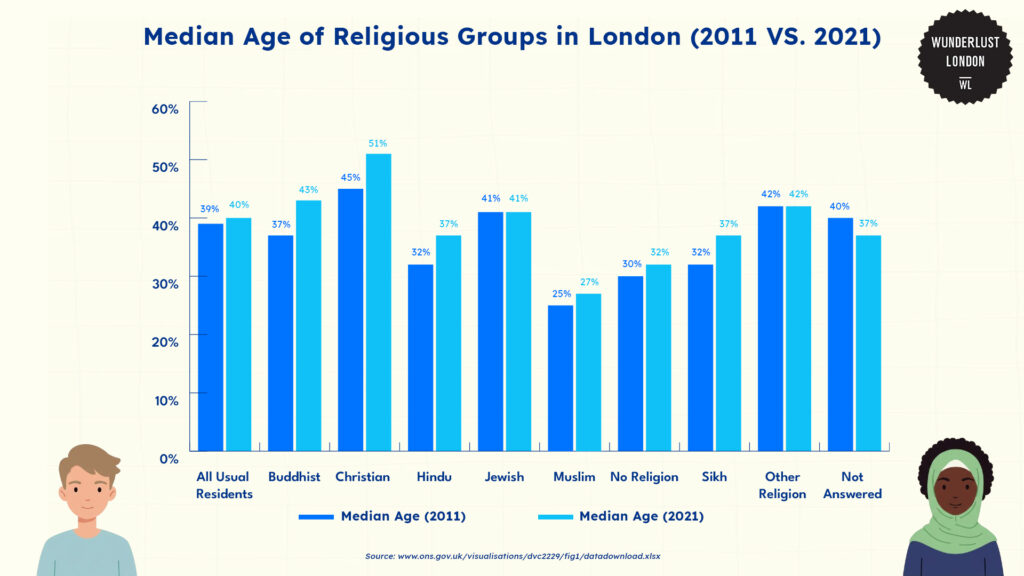
Based on Office for National Statistics’s data about median ages in London after a decade, there’s a clear pattern emerging that most groups are getting older.
Christianity, in particular, has seen a noticeable increase, with the median age rising from 45 to 51. This suggests that the Christian population is aging, possibly because fewer young people are identifying with the religion.
A similar trend is visible among Buddhists, Hindus, and Sikhs.
Muslims stand out as the youngest religious group, with a median age of 27 in 2021. While they have also aged slightly, their community remains much younger compared to other religions. This could indicate higher birth rates or a growing younger population.
Those who identified as having no religion have also aged, but at a slower rate. Secularism might not just be a trend among the younger generation. Older individuals may also be shifting away from religious identification.
The group of people who didn’t answer the religion question has gotten younger. This might suggest that more young people are choosing not to disclose their beliefs or are uncertain about their religious identity.
Demographic analysis of religions in London by gender
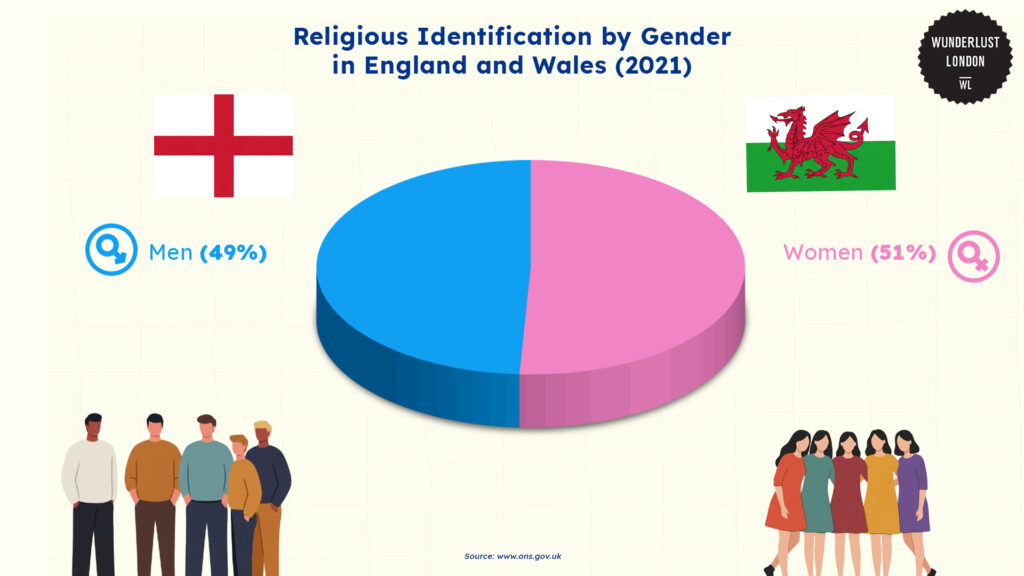
Data from the Office for National Statistics showed that slightly more women (51%) than men (49%) identified with a religion.
This pattern is consistent with broader trends seen in religious participation. Studies often show that women are more likely to be involved in religious or spiritual practices.
Cultural expectations, personal beliefs, and social roles may contribute to this difference.
While the gap is small, it suggests that religion might play a slightly bigger role in the lives of women. On the other hand, the nearly equal split also shows that religious identification is not overwhelmingly dominated by one gender.
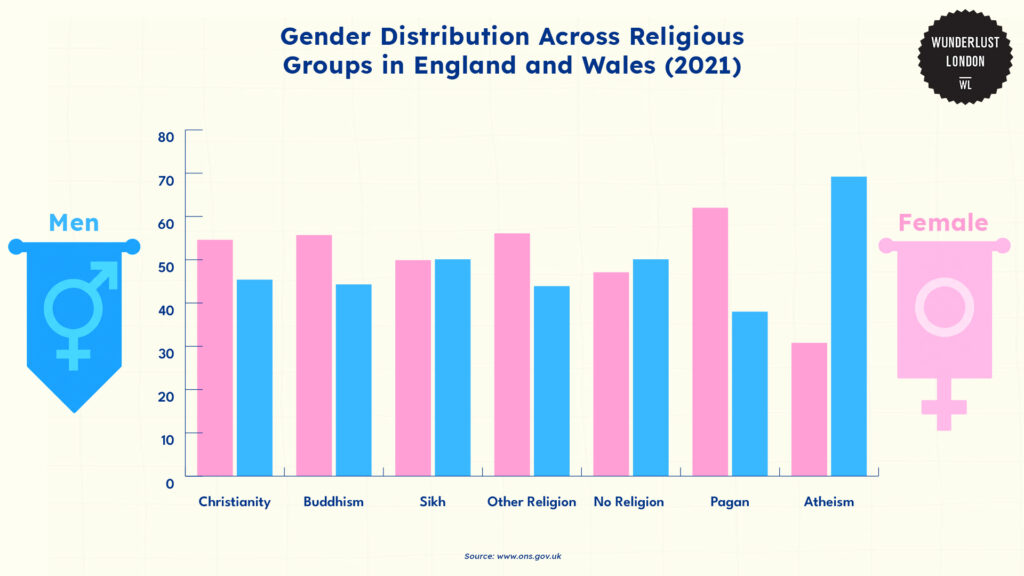
Office for National Statistics data shows that Christianity, Buddhism, and the “Other Religion” category all have a higher percentage of women followers.
Sikhism is the most evenly split religion, with almost equal numbers of men and women. This balance may reflect cultural values that emphasise gender equality within the religion.
On the other hand, men are more likely to identify as having no religion, a trend reinforced by the fact that nearly 70% of identified atheists are men. This could indicate that men are generally more skeptical of religious beliefs or willing to reject religious identification.
Paganism had the largest gender gap, with significantly more women identifying with it.
Demographic analysis of religions by employment status
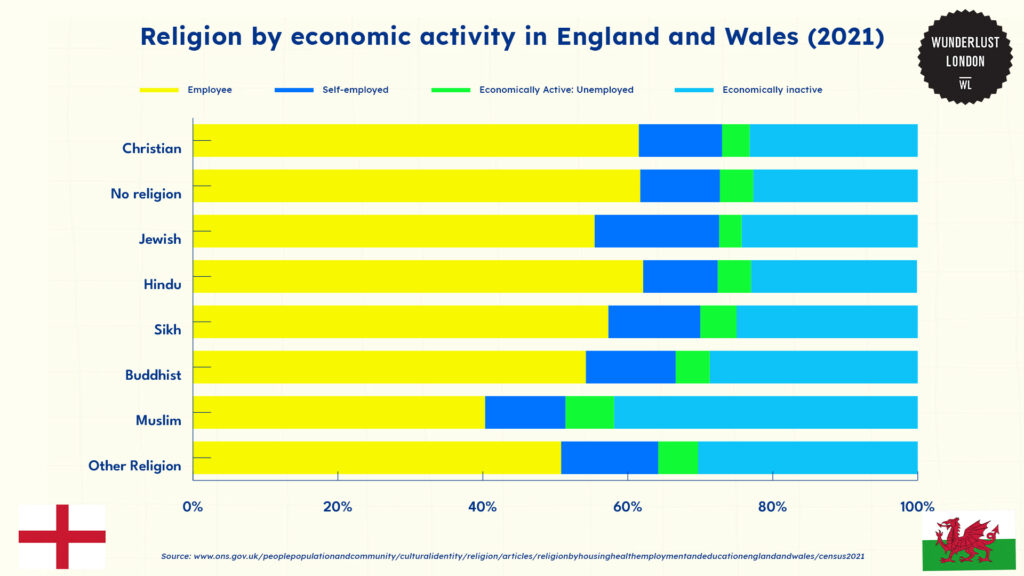
In 2021, the Office for National Statistics data showed how employment varies across different religious groups in the UK.
Hindus and those with no religion have the highest percentage of employees, suggesting strong workforce participation.
Jewish individuals stand out with a high rate of self-employment, which could indicate a strong tradition of entrepreneurship.
Muslims have the lowest employment rate and the highest percentage of economically inactive individuals. This could point to barriers such as education levels, workplace discrimination, or cultural factors affecting job participation.
The economic and social value of churches in London
Church buildings in the UK are more than just places of worship. They also play a huge role in the economy and society.
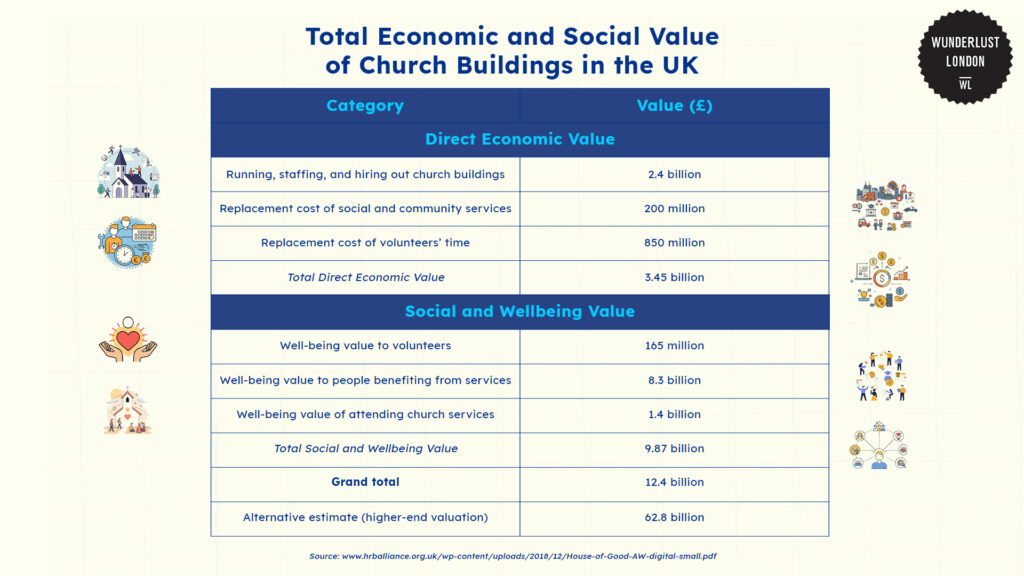
In 2020, National Churches Trust shared that churches in the UK contribute £12.4 billion annually.
A large part of this comes from running and staffing the buildings, hiring them out for events, and the value of volunteer work, which together add up to £3.45 billion.
Churches also fill gaps in social services, providing food banks, mental health support, and youth programs that would cost £200 million to replace.
Beyond the financial side, churches have an even greater impact on people’s well-being, valued at £9.87 billion a year. This includes the support they provide to communities, the personal benefits of attending services, and the positive effects on volunteers themselves.
To put this into perspective, the total contribution of churches is about the same as what the National Health Service (NHS) spent on mental health in 2018.
If a broader approach to valuation is used, the impact could be as high as £62.8 billion, which is nearly half of the entire budget in 2019.
Despite this, churches receive no guaranteed public funding.
Policy measures by the London government to address issues in religions
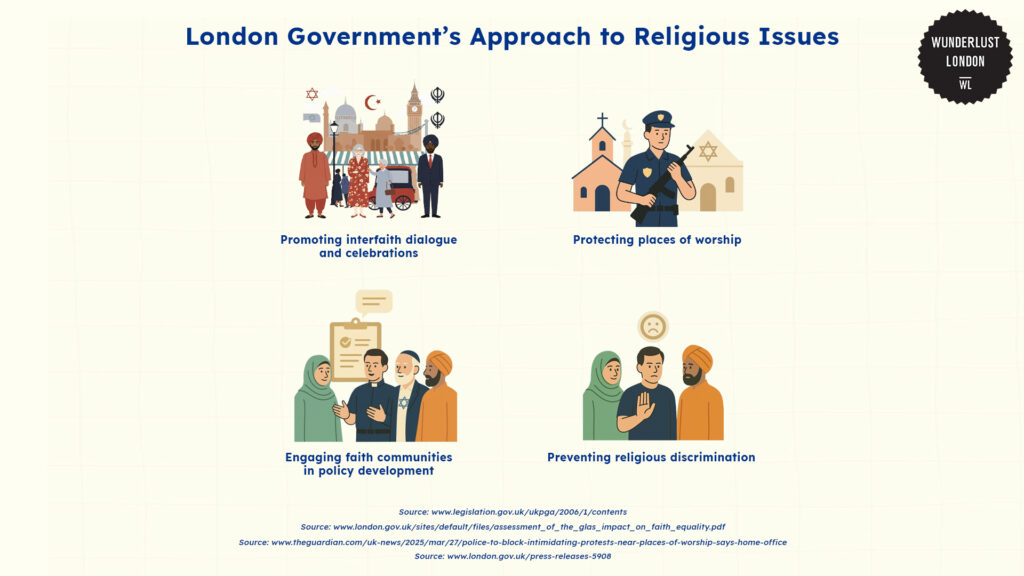
The London government actively promotes interfaith dialogue and celebrates the city’s diverse religious communities through various initiatives. The city supports major religious festivals like Eid, Chanukah, Diwali, Vaisakhi, and the annual Christmas Carol Service.
In 2013, the Mayor’s office also hosted receptions that brought together over 100 faith leaders to acknowledge and celebrate the role of religious communities in London.
The UK government has also given police in England and Wales the power to change the route and timing of protest marches outside places of worship.
This aims to prevent intimidation, especially following concerns over protests near synagogues and mosques, as reported by The Guardian.
The Greater London Authority (GLA) also works closely with faith communities to make sure their voices are heard in shaping policies that affect them. Faith leaders are often consulted on issues like social inclusion and housing.
GLA is also committed to protecting religious communities from discrimination. It supports laws, like the Racial and Religious Hatred Act 2006, that make it illegal to spread hatred against people based on their religion.
References
- Assessment of the GLA’s impact on faith equality. Greater London Authority. (2014). https://www.london.gov.uk/sites/default/files/assessment_of_the_glas_impact_on_faith_equality.pdf
- Faith communities. London City Hall. (2017). https://www.london.gov.uk/programmes-strategies/communities-and-social-justice/communities-london-how-were-improving-equality/faith-communities
- London Borough of Waltham Forest. (2022). SACRE Annual Report 2021-22. London Borough of Waltham Forest. https://www.walthamforest.gov.uk/media/5348
- London Borough of Waltham Forest. (2024). Religion . London Borough of Waltham Forest. https://www.walthamforest.gov.uk/health-and-wellbeing/population/religion
- London Borough of Waltham Forest. (2025). Statistics about the borough. London Borough of Waltham Forest. https://www.walthamforest.gov.uk/council-and-elections/about-us/statistics-about-borough
- Mayor to meet with London’s faith leaders at City Hall. London City Hall. (2015). https://www.london.gov.uk/press-releases-5908
- Median ages of religious groups, England and Wales, 2011 and 2021. Office for National Statistics. (2021). https://www.ons.gov.uk/visualisations/dvc2237/fig1/datadownload.xlsx
- Mitchell, T. (2016). The gender gap in religion around the world. Pew Research Center. https://www.pewresearch.org/religion/2016/03/22/the-gender-gap-in-religion-around-the-world/
- National Churches Trust. (2020). The economic and social value of church buildings to the UK. National Churches Trust. https://www.houseofgood.nationalchurchestrust.org/wp-content/uploads/2020/10/House-of-Good-AW-digital-small.pdf
- Population by religion, borough. London Data Store. (2018). https://data.london.gov.uk/dataset/percentage-population-religion-borough?resource=abfb6175-f489-4c6e-add2-f4d323183224
- Ransley, J., & Sarah Wood. (2023, January 30). Religion by age and sex, England and Wales: Census 2021. Office for National Statistics. https://www.ons.gov.uk/peoplepopulationandcommunity/culturalidentity/religion/articles/religionbyageandsexenglandandwales/census2021
- Ransley, J., & Wood, S. (2023, March 24). Religion by housing, Health, employment, and Education, England and Wales: Census 2021. Office for National Statistics. https://www.ons.gov.uk/peoplepopulationandcommunity/culturalidentity/religion/articles/religionbyhousinghealthemploymentandeducationenglandandwales/census2021
- Religious Discrimination. Greater London Authority. (2005). https://www.london.gov.uk/who-we-are/what-london-assembly-does/questions-mayor/find-an-answer/religious-discrimination
- Roskams, M. (2022). Religion, England and Wales: Census 2021. Office for National Statistics. https://www.ons.gov.uk/peoplepopulationandcommunity/culturalidentity/religion/bulletins/religionenglandandwales/census2021
- Sherwood, H. (2025). Police to block “intimidating” protests near places of worship, says Home Office. The Guardian. https://www.theguardian.com/uk-news/2025/mar/27/police-to-block-intimidating-protests-near-places-of-worship-says-home-office
- Statute Law Database. (n.d.). Racial and religious hatred act 2006. Legislation.gov.uk. https://www.legislation.gov.uk/ukpga/2006/1/contents
